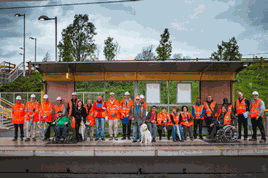This year’s ‘Railway Oscars’ proved to be a memorable night for Transport for Greater Manchester, which claimed two major prizes at RAIL’s National Rail Awards at London’s Grosvenor House Hotel in September (RAIL 784).
While the Civil Engineering Achievement of the Year award, for the early delivery of the Metrolink line to Manchester Airport (RAIL 787), may seem to be the more high profile accolade, the second award secured by the regional transport authority is just as significant.
This was the Putting Passengers First award, which went to Transport for Greater Manchester (TfGM) for its innovative Disability Design Reference Group.
One of the key advantages of Metrolink since its inception in 1992 is that the tramway has been built to be fully accessible to all users, whether able-bodied or disabled. Greater Manchester Passenger Transport Executive (as TfGM was then known) wanted to ensure that as many people as possible could easily use Metrolink, and thus the needs of the disabled have been considered at all stages.
During the first phase of Metrolink, which entailed the conversion of two former British Rail lines for use by the new trams, disabled ramps and lifts were installed at station stops, and platforms modified so that level step-free access to the trams was available for wheelchair users and people with lower levels of mobility.
This opened up new travel opportunities to many passengers who up to that point had been largely unable to use the train services that had previously served the routes, in the days before legislation was introduced to make transport operators consider the needs of disabled users.
Making Metrolink a welcoming and useful service to disabled users is just part of TfGM’s aim to make sure that all forms of public transport under its jurisdiction are accessible to as many people as possible.
But rather than simply paying lip service to the various pieces of legislation relating to disabled users, the organisation decided to go further and establish a working group of disabled people who could offer advice and guidance in relation to the expansion of the Metrolink network.
This was a way of establishing the practicalities of delivering such a big project while also considering the needs of disabled users. And the new group would be known as the Disability Design Reference Group (DDRG).
Back in 2008, TfGM tendered for a company to manage the recruitment, training and organisation of the DDRG, which would be tasked with consulting on and informing how access improvements to Metrolink services for disabled users could be applied.
The successful tender was awarded to Breakthrough UK Ltd, a disabled people’s charity that identifies and addresses barriers to the participation of disabled people at all levels of society. The organisation does this by fully involving and working in partnership with disabled people, their organisations and supporters.
Breakthrough recruited a reference group to form the DDRG, representing a range of disability types - consisting of people from differing ethnic backgrounds, men and women, and people from different age groups.
The DDRG’s aims are to provide:
- Balanced, constructive and pragmatic advice based on lived experience.
- Representation and perspectives from a thorough cross-section of impairments.
- Impartiality and transparency.
- Insight into the accessibility of all aspects of the Greater Manchester transport network, which will increasingly be utilised as the group’s remit expands.
- Support and challenge to transport network professionals, architects, planners and others, as applicable.
Each year Breakthrough provides a report detailing its involvement in projects throughout the year. The group also meets on 11 occasions each year, with additional site visits organised when required.















Login to comment
Comments
No comments have been made yet.